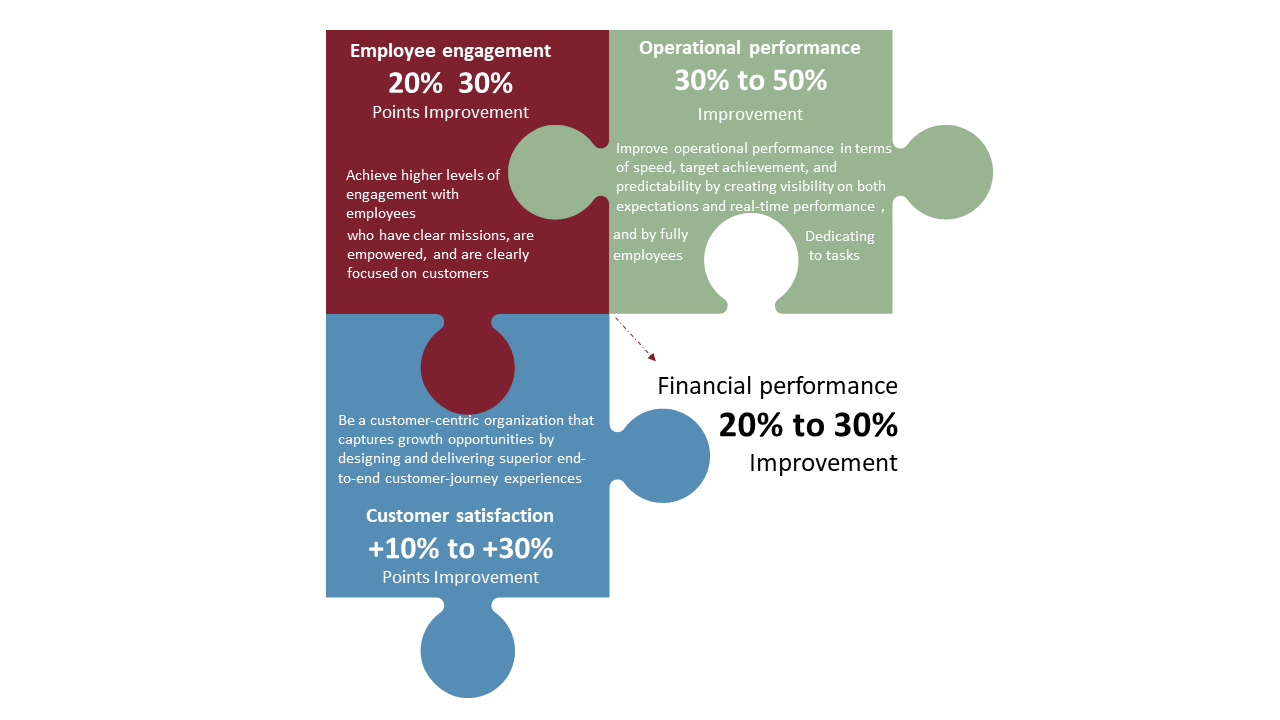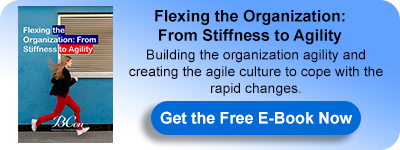The Benefits of Adopting Organizational Agility
Enterprise agility which was formerly considered desirable is now essentially required. Agility across an entire organization combines speed and stability; it aids role clarity, innovation, and operational discipline; and it can have a favorable impact on the health and performance of an organization. Although CEOs appreciate the benefits of agility, those considering an enterprise-wide agile transformation are questioning both the feasibility of such a project and the results they should achieve.
As part of the Mckinsey global agile-research endeavor, they looked at the impact of enterprise-wide agile changes. Twenty-two companies were researched across six industries. Preliminary findings showed that agile transitions boost customer happiness, employee engagement, and operational success. This is referred to as the "agile impact engine." The advantages reinforce each other, resulting in a fourth result: improved financial results.

1. Agility Has the Potential to Improve the Customer Experience by Up to 30 Percent
Unsurprisingly, using corporate agility to meet constantly changing consumer expectations can improve customer experience. Agile transformations resulted in a ten-to-thirty-point increase in customer satisfaction and engagement in the examples researched.
The change toward a customer obsession, which is critical for any agility, is an evident cause of this impact on customer experience. Customers come to the organization's center throughout an agile transition, and the "North Star" (a common purpose and vision across the organization) usually revolves around customer needs.
A flexible network of teams is another factor that improves customer satisfaction and one of the five trademarks of an agile company. Teams must operate with high alignment standards, responsibility, expertise, transparency, and collaboration to achieve a successful agile transition.
2. Agility Leads to a Potential 20 to 30 Percent Improvement in Employee Engagement
Employee engagement is a second area where agility's benefit is plainly apparent. Compared to a nonagile environment, the sampled firms enjoy a 20- to a 30-point increase in engagement in an agile context. Employee willingness to promote their workplaces or internal employee satisfaction surveys both showed an increase in involvement.
Several variables could explain the impact of agility on employee engagement. Employees have the potential to acquire a strong sense of autonomy, mastery, and purpose in the non-hierarchical organization of cross-functional teams. Employee happiness and engagement are improved as a result of these initiatives.
3. Unlock a Performance Improvement of Up to 30 to 50 Percent
Metrics for operational performance differ by industry. The Mckinsey sample has common examples of time to market, planning time, issue-resolution speed, predictability, and raw product output. Speed, target-achievement rates (TARs), and other industry-specific measures fall into three categories. According to the study, executing an agile transformation can enhance these indicators by 30 to 50 percent.
A. Increasing Speed
Organizations can use agility to speed up decision-making and product development and reduce the period between product conception and release (known as “time to market”). They fantasize about a configuration that will allow them to leap ahead of their competition in product development.
This proved to be true in a telecom company in the research samples. Because of the company's new, agile setup, it responded to its competitors' new product releases in one week rather than several months, cutting time to market by up to 70%. Overall, according to the research findings, agile transformation can cut time to market by at least 40%.
B. Improving Target Achievement Rate
The TAR is another operational statistic that improves significantly after agile conversions. The TAR is 70% if you capture 70,000 new clients out of a target of 100,000 new consumers. Whereas most traditional businesses struggle to fulfill their goals (falling short of 100 percent), all agile businesses in the research sample, exception for one, exceeded their goals: The percentages varied from 90% to 140 %.
C. Raising Sector-Specific Metrics
Many industry-specific operational metrics demonstrate the advantages of agility. Increasing the amount of gas produced per employee was a crucial operational metric for one Australian liquefied natural gas facility. The producer increased overall gas production by 5 to 10% by implementing agile approaches such as transferring technical middle managers to "doers" and generating semiautonomous operating assets. However, by using these approaches to reduce full-time-equivalent hours (and by decreasing its organizational layers to four), the overall increase in gas production per employee increased by 70 to 80 %.
4. Agility Improved Financial Performance by 20 to 30 Percent
Although cost reductions are rarely the primary goal of an agile transformation, they are a natural byproduct of enhanced operational performance and the ability to achieve the same results with less personnel. The research sample found 20 to 30 percent savings on both internal and external costs. Importantly, in numerous situations, corporations re-invested a portion of their savings to pursue new business prospects, implying that these savings were not included in profit and loss.
So far, research has shown that the reward for business agility is a significant increase in numerous organizational outcomes. The findings apply to successful agile-transformation implementations in various industries and locations. Agility is no longer just desired; it is becoming vital as pressures increase to develop inventive methods to stay competitive in today's fast-changing circumstances.
1 Mckinsey and Company, 20 Mar 2020, Wouter Aghina, Christopher Handscomb, Jesper Ludolph, Daniel Rona, and Dave West, Enterprise agility: Buzz or business impact?, Accessed 14 Apr 2022, https://www.mckinsey.com/business-functions/people-and-organizational-performance/our-insights/enterprise-agility-buzz-or-business-impact
For more about this topic, download our latest book " Flexing the Organization: From Stiffness to Agility " for FREE:
